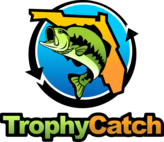
Warmer weather and the post-spawn period have not stopped the flow of Hall of Fame submissions, and Season 9 is shaping up to be a record-breaker, with a full quarter left to go with the season wrapping up on September 30. Recent season stats are at:
- 763 Lunker Club (8 - 9.9 lbs.) bass
- 226 Trophy Club (10 - 12.9 lbs.) bass
- 25 Hall of Fame (13+ lbs.) bass
The Lake Apopka Challenge concluded on May 31, and some interesting results from the event are provided in the "Apopka Challenge Research Results" article below. Popular posts on the TrophyCatch Facebook page (below) included a reminder to anglers not to be in possession of more than one bass over 16 inches or longer unless fishing a permitted tournament, and Maggie Shepherd's 8 lbs. Lunker Club bass from Lake Juliana in Polk County. Good luck and tight lines to all our TrophyCatch participants as we enter the final turn of Season 9. Don't wait until you catch a trophy bass — register now at TrophyCatch.com and be automatically entered in a free drawing for a Phoenix bass boat!
|
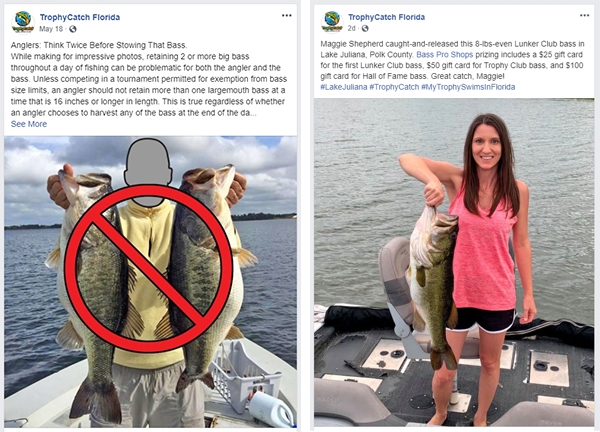 Follow the TrophyCatch Facebook page to see the latest big catches and stay up-to-date on TrophyCatch news.
Notable recent catches included Shawn Elder's 10 lbs. 9 oz. bass from Lake County.
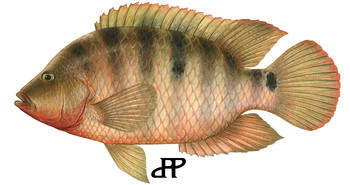
Size: The current State Record is 2.37 pounds, and the minimum sizes for Big Catch are 1 pound or 11 inches for adults, and 0.75 pounds or 8 inches for youth.
Identification and similar species: The broken lateral line and turquoise ring on the tail are diagnostic; general coloration includes 6-8 bars that can be faint or dark; body color varies greatly in intensity sometimes with bright red on the chin, throat, and breast; has both spiny and soft dorsal fins and a rounded tail fin. These colorful fish are sometimes mistaken for another cichlid, the butterfly peacock bass which is more elongated and usually has a yellow ring on the tail. These fish have several nicknames including "reds" and "cichlids."
Angling qualities: Sometimes referred to as the "atomic sunfish" for its bright colors and strong fight. The Mayan takes a variety of natural baits including live worms, grass shrimp, and crickets, as well as almost any small artificial, particularly jigs, fished on light tackle; wooly worms, small streamers, and popping bugs used by flyfishers also taken aggressively.
Edibility: Good; white to pink, flaky meat with mild flavor. No bag or size limits means anglers can catch and keep as many Mayan cichlids as they can catch.
Where to find them: First recorded in Florida Bay in 1983, now established and abundant in south Florida as far north as Lake Okeechobee and the St. Lucie Canal. Native to Atlantic slope of Central and South America. Very adaptable and lives well in variety of habitats including canals, rivers, lakes and marshes; tolerates a wide range of salinities.
Fish graphic by Diane Rome Peebles
|
The lowly catfish gets no respect. Maybe it’s his habit of loafing around on the bottom of our lakes and canals. Or perhaps it’s because he won’t jump in a spray of aerial gymnastics. But those who don’t respect Mr. Whiskers probably haven’t faced the challenge of hooking a wary, angler-smart cat, or locked rods with a really big one. Fishing for catfish can be as demanding as most other forms of angling. On the other hand, catfishing can also be one of the more relaxed methods of fishing — especially during Florida’s lazy summer months. Whatever your desired level of challenge, fishing for catfish is worth a try.
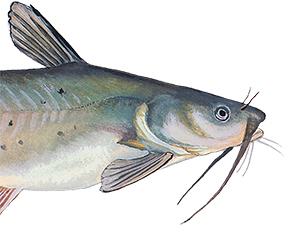
There are several species of catfish you’re likely to come across. One of the most popular is the channel catfish, stocked by the FWC in many Fish Management Areas across the state. The channel cat regularly achieves weights of over ten pounds. And the potential size is much greater — the Florida record stands at 44.5 pounds. Great baits for channels include commercial “stink baits,” chicken or beef livers, cut sardines or shiners, and live worms. A good channel cat outfit is a medium spinning or casting rig spooled with 8-12 pound test line, depending on the size of the catfish you expect to encounter. However, if you’re going after really big ones, line testing up to 20-30 pounds is not unreasonable. Depending on the size of fish you expect, use hook sizes ranging from 6 to 2/0 or larger. Aberdeen, baitholder and circle hooks are all popular choices for catfish, but the latter is most recommended, especially if you’re not planning to keep what you catch. Circle hooks, in addition to reducing the chances of gut-hooking, may also increase your percentage of solid hookups. Baits are usually fished directly on the bottom, with an egg sinker added for casting distance if needed. However, for wary biters in more heavily fished areas, no weight at all and a relatively light line gets more hookups. Otherwise, casting your bait into the deeper areas or channels of any lake or canal will usually find fish. Some anglers also do well floating their bait just off the bottom, suspended under a bobber. Fish attractants applied to your bait will help catfish, which have a highly developed sense of smell, find your bait quickly. You can set out two or three rods, cast out in a fan pattern from your spot on the bank, and prop them up so that you can keep a close eye on the lines dangling from the rod tips. If using spinning rigs leave the bail open; anglers that use baitcasters should put the reel in free-spool and engage the clicker if their reels have one. When line starts spilling off the spool or your reel starts chattering, you know a cat’s just hit your bait! If using circle hooks, gradually tighten up on the line instead of using the traditional hook-set. Almost everything just stated will also apply to the smaller white catfish found throughout most of Florida. Although catfish usually won’t take to the air, they will put up a strong fight — especially the bigger ones. While bass may jump and splash, a decent-sized catfish will make long, steady runs that will add a “Whoa!” to your fishing trip.
|
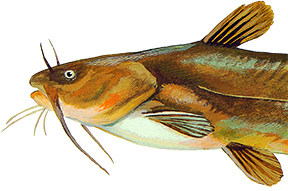
Yellow (shown) and brown bullheads are other catfish species that anglers will find throughout Florida. Sizes are much smaller, with the state yellow and brown bullhead records standing at 5.05 and 7.02 pounds, respectively. Gear should be correspondingly lighter, with a medium-light outfit strung with 6-8 pound line just about right. Baits will be similar, but with live worms being more effective for bullheads than for channel catfish. Bullheads seem to take to our man-made canals more readily than channel catfish, and may also be more readily found than channels in places where the latter are not regularly stocked.
|
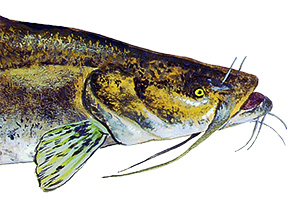
For a true challenge, monstrous flathead (shown) and blue catfish are found in northwest Florida. State records for these behemoths stand at 69.9 pounds for the flathead, and an almost identical 69.5 for the blue. Catching these giants is a much more specialized project demanding heavy saltwater fishing gear and much larger baits, often whole live or cut fish. This isn't a "lazy" fishing trip, but both species add to the diversity of fishing to be found in the Sunshine State.
Most catfish perform well in the frying pan, and that’s usually how you’ll want to prepare them. Dipped in egg and seasoned bread crumbs or cornmeal, cats will fry up nicely. They have a clean white meat that serves well. Flavor can vary, and an occasional complaint with catfish is that they may taste fishy out of certain locales. Some anglers only keep smaller fish, up to only two or three pounds, claiming that they taste better than the bigger fish.
So if you haven’t gone after some catfish recently, throw a lawn chair and a jug of tea in the truck and grab a package of chicken livers for an evening outing. Whether you’re looking for a fresh challenge or just want to sit back and take it easy for a few hours, you might develop a new-found admiration for Mr. Whiskers!
Fish graphics by Duane Raver, Jr.
|
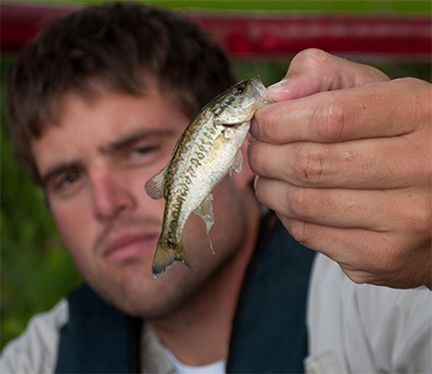 |
Thank you to everyone who participated in the Apopka Fishing Challenge! The Friends of Lake Apopka partnered with the FWC to tag a variety of sportfish in Lake Apopka including largemouth bass, black crappie (specks), and bluegill to help promote fishing on the lake. The event ran through May 31 and produced some very interesting results. Here was the "Tag Tally":
- 500 tags deployed
- 25 total tags caught
- 23 were bass tags
- 70% of tags were caught by tournament anglers
- Most tagged bass were caught near tagging locations, but a few bass traveled up to 5 miles away!
The purpose of the Challenge was to promote recent enhancements completed on Lake Apopka. To boost the bass population, the FWC stocked over 1.4 million fingerling largemouth bass in Lake Apopka in the fall of 2016 and 2017. These bass are now 3 to 4 years old and based on sampling data they are now a very catchable size greater than 20 inches.
Bass "Jim Thomas," tagged, caught and released to continue roaming Lake Apopka!
The star of the show was tagged twelve-pound bass "Jim Thomas," named after the Winter Garden environmentalist who founded the Friends of Lake Apopka. Christian Greico from Tampa caught the bass during a tournament (inset above) and received $2,500 for reporting the tag, and another $2,500 for successfully submitting the bass into the TrophyCatch program.

Every Fall and Spring, the FWC monitors the fish population on Lake Apopka using electrofishing. Each year they sample some giant (10+ lbs.) TrophyCatch-class bass. Based on this sampling, Lake Apopka has a very fast-growing bass population reaching 16 inches in 2 years, and roughly 40% of the shoreline has comparable catch rates compared to the rest of the Harris Chain of Lakes. Check out the "hot spots" map below highlighting the areas on the lake where good numbers of quality sized bass (larger than 16”) were sampled. Lake Apopka also offers anglers great panfish opportunities. During the FWC’s fall sampling on Lake Apopka, bigger bluegill and higher numbers of black crappie have been observed compared to other Harris Chain Lakes.
|
Marked in red is where the bass fishing in Lake Apopka should be best, with good numbers of quality sized bass larger than 16” sampled by FWC biologists.
Size: 730 square miles
Location: Palm Beach, Martin, Glades, Okeechobee, and Hendry counties
Description: Lake Okeechobee is Florida's largest lake and the second largest body of fresh water in the contiguous United States. The word Okeechobee comes from the Seminole Indian language "Oki" (water) and "Chubi" (big) and means "big water." These early Floridians chose the name well. Vast surface area (730 square miles), shallowness (averaging only nine feet deep) and enormous habitat diversity makes the ecosystem unique on the North American continent. The lake is a multiple-use resource, which supports valuable commercial and sport fisheries, provides flood control and acts as a reservoir for potable and irrigation water for much of south Florida.
Lake Okeechobee is located on the south-central portion of the Florida peninsula about an hour and a half south of Orlando. Major natural tributaries to the lake are Fisheating Creek, Taylor Creek and the Kissimmee River. Sheet outflow occurred historically across the entire southern rim into the Everglades. Lake Okeechobee is now connected to the Atlantic Ocean through the St. Lucie Canal as well as the Gulf of Mexico through the Caloosahatchee River.
The lake’s aquatic plant communities provide crucial areas where fish spawn, forage, and hide from predators. Historically, the bulrush community has yielded a high abundance of sportfish such as Largemouth Bass, Bluegill, as well as important forage species like Golden shiner. Submersed aquatic vegetation (SAV) such as eelgrass, hydrilla, and Illinois pondweed (commonly known as peppergrass) also yield high abundance of fish, and have been strongly linked to the recruitment and survival of young sportfish like Largemouth Bass. These plant communities and others provide great fishing in Lake Okeechobee, especially when they create a mosaic of habitat.

Fishing: Bass fishing is good year-round in Okeechobee, but is the best during the months of December through April when they are typically spawning. Crappie fishing is also best during their spawning season between January and March. The bluegill and redear sunfish usually begin spawning in late March and will continue through the beginning of June.
Creel surveys on Okeechobee have shown recent improvements in bass and crappie catch rates this past fall and winter. Big bass have remained abundant, with many anglers catching fish over eight pounds, and winning tournament weights have commonly reached or exceeded 30 pounds. Anglers targeting crappie have had good success harvesting their bag limit of 25 fish.
|
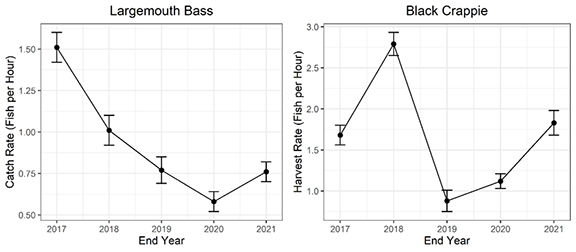 Creel surveys on Lake Okeechobee have shown recent improvements in bass and crappie catch rates.
Outlook: Likely due in part to submerged aquatic vegetation (SAV) recovery since Hurricane Irma, last year’s fall electrofishing showed a strong class of new “young-of-year” bass for the first time since 2016. A strong year class like this can help sustain a fishery for years to come. Anglers will likely start catching this cohort during the next year, and with Lake Okeechobee’s fast growth rate, we can expect to start seeing these fish in TrophyCatch by just six years old.
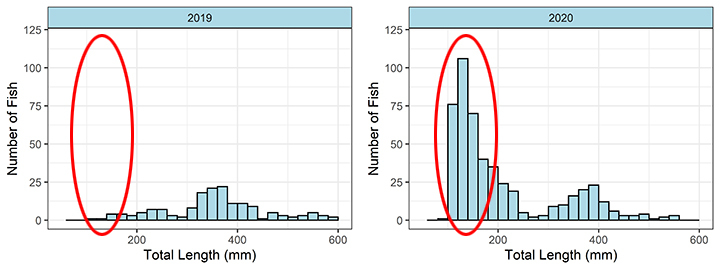 Last year’s fall electrofishing showed a strong class of new “young-of-year” bass for the first time since 2016.
A similarly strong year class of crappie was born in 2018. Crappie need around three years or more to grow to the minimum size of 10 inches on Okeechobee, and these fish made their way into the fishery this past season, helping drive the successful harvest rates. We expect these fish to continue sustaining the fishery over the next few years, as the age of crappie harvested from Lake Okeechobee often peaks between four to five years old.
Management Plan: Beginning in early 2020, the FWC began the development of a Lake Management Plan for Okeechobee. The FWC’s Lake Management Plans are meant to be comprehensive, covering management activities within the FWC’s jurisdiction, such as a system’s fish, wildlife and habitats, while also providing recommendations to partner agencies on items outside of that jurisdiction, such as water levels and water quality.
The first phase of planning included the gathering of initial thoughts and suggestions through public meetings, stakeholder interviews, and stakeholder workshops. We then used this information to draft a survey over the winter of 2020-2021 to learn more about specific areas of interest, and drafted goals and objectives with the target of achieving both ecological health and stakeholder support. At the time of this writing, the Lake Okeechobee goals and objectives have been organized into four focal areas of Fish and Wildlife Management, Plant and Habitat Management, and Communication and Interagency Coordination. Encompassing the diversity of the lake’s resources and the feedback heard, the goals and objectives range from metrics supporting fishing and hunting opportunities to how we manage habitat, invasive plants, and work across lines with our partner agencies. You can view the full list of goals and objectives, or visit our management plan web page.
To contact the Florida Freshwater Angler, email John Cimbaro.
|